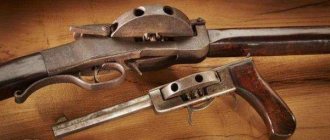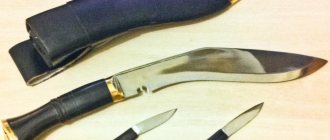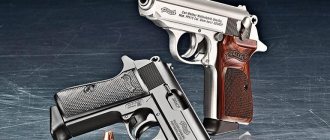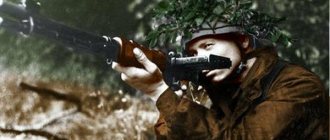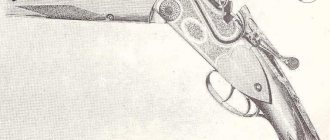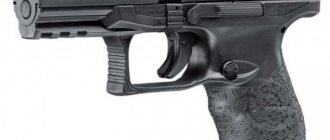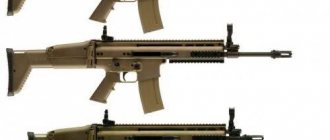The 16th century, which followed the Middle Ages, became the era of the heyday of firearms. The European wars that swept the continent clearly demonstrated the growing power of handguns. Crossbows were replaced by arquebuses and muskets, which gradually became the dominant means of combat. Weapons such as the arquebus turned ordinary infantry into a more powerful branch of the army. From this moment on, the “fire battle” regiments became the main ones in the army of that time, and along with the cavalry and the first artillery units they were the main striking force.
Arquebus in hands
Where do the roots of arquebuses and arquebuses grow?
Despite the fact that many people associate the arquebus with Spanish roots, the term is of German origin. The first examples of this firearm appeared at the end of the 15th century in Germany and were called “hakenbucdse”. Literally, this difficult-to-read word translates as a gun with a hook. Similar weapons appear in almost all countries of the European continent. The arquebus came to Russia from Poland and Germany and was called a arquebus. They were used by warriors, who later formed the basis for rifle regiments.
A later modification of the arquebus - the musket - became the main type of small arms for infantry units. The name, appearance, and design of the products changed, while the principle of operation of the weapon remained the same. Thanks to the Age of Discovery, which saw the heyday of handguns, the arquebus and musket came to the Far East. In the armies of the Japanese shoguns, arquebuser units appeared already in the middle of the 16th century.
Despite the primitive design of the first combat models, the new weapon was able to show its high firepower on the battlefield. The product was a metal pipe placed in a wooden box. The barrel of the arquebus was smooth-bore, and the powder charge placed in the breech was ignited by a wick. Such weapons were commonly called matchlock guns. This gun fired heavy round lead or tin bullets.
Arquebus
The main distinguishing feature of the first samples is the imperfect design of the product, which was reflected in the significant weight of the weapon. The infantryman had to carry a gun weighing about 20 kg on the battlefield, so most often this type of weapon was used for shooting from closed positions for defensive purposes. Along with this, trying to use the advantages of firearms as efficiently as possible, in the armies of European states there is a gradual division of arquebuses into two types, light and heavy. The first were a hand-held smoothbore gun. The second type was considered a serf type of weapon.
The lack of a stock significantly limited the scope of use of this type of weapon in field conditions. To fire, the shooter had to hold the gun under his armpit. Shooting was carried out only from point blank range. The weapon of German origin had a special hook for these purposes, hence the name “gun with a hook.” The infantry version was smaller in size and accordingly was used by “fire formation” regiments operating in line formation.
Line of arquebusers
The technology for making matchlock guns at that time was not particularly complex. Compared to the cost of making a crossbow, the arquebus was easier to make and therefore cheaper. Simple and straightforward operation, transportation and storage made this type of weapon widespread, even taking into account its imperfect firing characteristics. The arquebus, which first appeared in service with German regiments, could fire at a distance of no more than 100 meters. Each shot required lengthy preparation. Often, raw gunpowder caused the weapon to fail at the most crucial moment. The crossbow was a much more practical weapon on the battlefield. Its heavy arrows flew up to 200 meters, and the shooter could fire almost continuously. The new weapon was not particularly accurate either. Hitting the target from a distance of 100 steps was quite problematic. Accuracy of fire was achieved by creating a high density of fire.
Gunpowder is being improved
The gunpowder that was in use at that time was also called serpentine. One of the disadvantages of serpentine gunpowder was its separation into separate fractions due to shaking or simply from time to time. The denser saltpeter and sulfur ended up at the bottom, and coal accumulated on top. As a result, the gunpowder did not ignite well. This problem was solved with the invention at the beginning of the 15th century. grain powder. During its manufacture, all components were ground and thoroughly mixed, and then sifted, so that as a result all particles were the same size.
Musketeer of the early 17th century. fires from a musket with a fuse. Muskets replaced arquebuses, small arms that were used from the 15th to the 17th centuries. The wick fuse gradually became lighter and more compact in structure and much more efficient in use
The influence of the arquebus on the perfection of combat tactics
Skepticism towards firearms has affected its frequency of use. Matchlock guns were effective when the situation on the battlefield did not imply intense active action. Battle tactics changed accordingly. A dense formation of riflemen, armed with arquebuses and muskets and going on the offensive, appeared in the armies a little later. The musketeers, placed in several rows, fired volleys in turns. Following the first line, the second line opened fire. Then the third line of shooters fired. During this time, the shooters occupying the front rows had time to reload the matchlock gun and prepare for the next shot. As a rule, firing from matchlock guns was carried out at that time with significant interruptions. On average, there was a time interval of 3-5 minutes between the first two salvoes, so the main trump card on the battlefield at that time was the accuracy of the first salvo.
Actions of arquebusers
The main effect was achieved after the first salvo. The accuracy of the shot did not play a key role at first. The roar and smoke caused panic on the other side. Militia units and horses often could not withstand the psychological stress of such an attack. A little later, when shooting accuracy has improved, the arquebus in the hands of an experienced shooter becomes a terrible and powerful weapon. The first salvo was capable of not only sweeping away the enemy’s infantry ranks from the battlefield, but also stopping the enemy cavalry rushing at full gallop.
Cavalry Charge
The action of the matchlock gun did not have high penetrating ability. A bullet fired from a smooth-bore weapon could not always penetrate the steel armor of horsemen. However, the force of the blow was such that the rider could simply be thrown out of the saddle. The actions of arquebusers on the battlefield in those days were regarded by noble and noble knights as a crime. There is an analogy here with the opposition of heavily armed knightly cavalry to the massive use of archers during a battle.
The first massive use of the arquebus and its analogues, matchlock guns, is attributed to the Hungarian king Matthias Corvinus, who managed to equip his troops with new types of firearms. Then the arquebus begins its victorious march across the entire European continent. The Burgundian and Italian wars of the late 15th and early 16th centuries marked the beginning of a new stage in equipping armies. The era of firearms has arrived, without the participation of which not a single battle or military clash could take place. The Battle of Pavia in 1525 marked the beginning of the widespread use of the arquebus and musket in the armies of other countries.
Cutting barrels and improving stocks
In the seventies of the 16th century, the most important stage in the improvement of small arms was the appearance of the first rifled barrels. They were invented by gunsmiths from Nuremberg, and the effectiveness of such an innovation immediately became obvious, since a rifled matchlock gun made it possible to hit targets with higher accuracy.
The butt had also undergone significant changes by this time. Previously, it was straight, and when shooting it had to be rested against the chest, which caused extreme inconvenience. The French craftsmen gave it a curved shape, which ensured that the recoil energy was directed not only backward, as before, but also upward. In addition, such a butt could be rested on the shoulder. It was this design that became classic and has been preserved in general terms to this day.
Modernization of the arquebus design
After much throwing and attempts to improve the weapon, a lightweight version of the weapon appears. Instead of the usual wick, which often caused shooters a lot of trouble, the arquebus received a wick lock. An ordinary wick cord was attached to serpentine, the presence of which accelerated the ignition of gunpowder in the breech of the barrel. On combat models, a prototype of the butt appears, thanks to which the accuracy of firing is significantly increased. The gun barrel is becoming more advanced. The transition from stone projectiles to metal bullets is ending. A bullet weighing 30-50 grams could now not only knock down a man-at-arms, but also pierce metal armor.
Arquebuser equipment
Bullets, like gunpowder, began to be stored in special bags, in pouches. The equipment of the arquebuser consisted of a powder flask (pouch) for seeding powder and a large powder flask in which the charging powder was stored. The shooter's combat equipment was supplemented by a couple of meters of wick cord. In addition to the arquebus, the shooters were armed with a sword or rapier. However, these units could not act independently on the battlefield. A prerequisite for the effective use of “fiery formation” regiments was their escort by detachments of pikemen and spearmen.
The arquebus becomes easier over time. Weapons specially created for mounted units appear. Thus, specimens no more than one meter long appear in the arsenal of the French cavalry. The weight of such a gun is 5-7 kg. In the middle of the 16th century, the final division of matchlock guns into arquebuses and muskets took place. The first category includes all small-caliber smoothbore guns. Muskets, on the contrary, are a heavy type of firearms, in which the main thing is a large caliber. Harquebusers were able to fire from their hands, while musketeers were able to open fire only from a special rest. It could be a bipod or a reed, like the archers in the Russian army.
Spanish tercio
Being a weapon that can safely be called the ancestor of the gun, the arquebus had a barrel with an average length of 50 calibers. Equipped with matchlocks, and a little later with wheel locks, these examples of firearms became a transitional type. The perfection of technology and the emergence of new tactical techniques led to the formation of a new type of weapon, a smoothbore gun, based on the arquebus and muskets.
Instead of wicks, a silicon lock appears. The caliber of the weapon is reduced and the barrel lengthened. Accordingly, the direct shot range and accuracy increase. A unitary paper cartridge makes the shooter’s actions on the battlefield as efficient and productive as possible. For another two centuries, the arquebus was considered the main weapon of fire on the battlefield. The transition to hammer-fired guns and pistols led to the fact that the matchlock gun gradually became a thing of history. On the battlefield, shooters were required to react quickly, and demands for density and accuracy of fire increased. Old systems did not meet the new requirements and quickly became history.
Spring wick lock
Around 1470, spring wick locks appeared, in which, instead of serpentine, there was a curved lever with a wick, driven by a compressed spring. When the trigger was pressed, the smoldering wick sharply dropped to the powder shelf and ignited the seed. A system of levers and springs was mounted under the locking plate. In Europe, such a mechanism soon gave way to more advanced models, but in Japan, where it was introduced in the 16th century. brought by Portuguese traders, the matchlock was used until the 19th century. The Japanese matchlock is a smaller version of a long gun, equipped with a large diameter barrel and a spring-loaded matchlock located on the side.
Decorated 18th century matchlock mechanism. Despite the complex design, the process of triggering the mechanism and igniting the gunpowder was very simple
Diagram of a spring wick lock. When the trigger was pressed, the burning wick approached the powder seed and ignited the charge. Thanks to the spring, the trigger with a wick connected to the trigger lever hit the powder shelf almost instantly
In the second half of the 16th century
In the second half of the 16th century, they switched to a new, more effective type of gunpowder. The previous one, crushed into dust, quickly stuck together due to the humid air, burned unevenly, and unburnt particles clogged the barrel and the seed hole.
Therefore, hard cakes were first sculpted from the powder mixture, and then crushed into relatively large grains, which, although they burned more slowly, released more energy. Such gunpowder successfully remained in service with the troops until the second half of the 19th century, when it was replaced by nitroglycerin.
The diagrams of the structure of a matchlock weapon show: A - serpentine (jagra),
B - the simplest wick lock with a sear,
B - improved matchlock of the second half of the 17th century (inside view).
Manual for infantrymen
In 1608, German publishers published a manual for infantrymen, illustrated by the famous Dutch engraver J. van Geyn. So, in the first part there were 42 drawings of methods for loading and unloading a musket, and in the second - 43 images of drill techniques adopted for musketeers. In some drawings, bandeliers are clearly visible - leather belts worn over the left shoulder of a soldier, to which 10 - 12 wooden, sometimes leather-lined vessels with measured portions of gunpowder were attached, a flask with small, seed gunpowder, a pouch made of horn, leather or wood, where bullets were kept , wads, needles for cleaning the seed hole, rags and scraper; They wore coiled wicks on a bandelier.
An interesting detail: on the march, every tenth soldier was supposed to keep the fuse lit so that, if necessary, his comrades could quickly “refuel the light.” Only after the appearance of ready-made cartridges in the 18th century were heavy bandeliers replaced with small cartridge belts, which were also thrown over the shoulder or fastened to the belt.
Russian handbrake from the late 14th - early 15th centuries.
